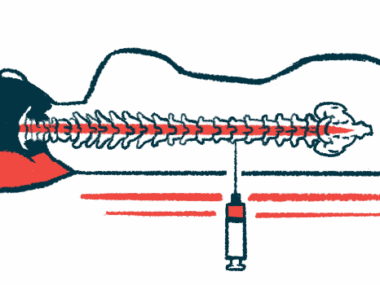Potential ASO Therapy Treats SMA in Mice With Evident Symptoms
Written by |

A new and noninvasive type of antisense oligonucleotide (ASO) therapy effectively treated spinal muscular atrophy (SMA) in a mouse model with established symptoms, a study reported.
Since symptomatic and late-onset SMA patients are the most difficult to treat, “our [therapy] should be considered a great improvement from a clinical perspective,” its scientists wrote. “We believe strongly in the feasibility of clinical translation and the utility” of this potential treatment “even in symptomatic SMA patients.”
The study, “Cell Penetrating peptide-conjugated Morpholino rescues SMA in a symptomatic preclinical model,” was published in the journal Molecular Therapy.
Nearly all cases of SMA are caused by a faulty SMN1 gene that encodes SMN, a protein essential for the survival of motor neurons, the nerve cells that control voluntary muscle movement. Disease severity is primarily determined by the number of copies of a second SMN2 gene, which can partly compensate for the loss of SMN1.
ASO-based therapy, such as the approved medicine Spinraza (nusinersen), can increase the ability of cells to produce functional SMN protein from the SMN2 gene.
But Spinraza’s use is invasive, being administered by injection in the space surrounding the spinal cord (intrathecal infusion).
In addition, current ASO therapy has a limited distribution in certain brain and spinal regions (CNS, central nervous system) that can hamper motor response in some patients, and it is more effective in some types of SMA more than others, the study noted.
Existing SMA treatments — which include the gene therapy Zolgensma and the oral therapy Evrysdi (risdiplam) in the U.S. — are also known to work best in the presymptomatic and earliest stages of the disease.
Researchers at the University of Milan in Italy aimed to address some of these issues by developing an ASO therapy that does not require invasive spinal injection, has wide ranging distribution, and can be potentially effective in symptomatic SMA.
Previously, this team and others showed that antisense oligonucleotides generated by a type of chemistry known as morpholino chemistry eased disease-related hallmarks following presymptomatic treatment in an SMA mouse model.
These researchers now investigated whether attaching (conjugating) small protein fragments called cell-penetrating peptides (CPPs) directly to morpholino-generated ASOs improved the medicine’s distribution throughout the CNS and enhanced overall efficacy in symptomatic SMA mice.
Initially, four different CPPs were attached to morpholino-generated ASOs and delivered by both intravenous (into-the-vein) injection or infusion directly into the area surrounding the brains of 1-day-old SMA mice.
Analysis confirmed that all ASOs tested significantly increased SMN protein levels in the brain and spinal cord by both administration methods. ASOs with two CPPs in particular — called r6 and RXR — were more effective in rescuing SMN than ASOs without CPPs.
Next, both RXR-ASO and r6-ASO were injected into the abdomen of 5-day-old SMA mice, corresponding to the symptomatic SMA phase.
Tissue analysis two days later demonstrated a significant increase in SMN protein in the brain and spinal cord versus control (untreated) mice. SMN protein was also significantly enhanced in heart, liver, and kidney tissues. Lower doses showed similar results.
An analysis of distribution found the r6-ASO was significantly higher in the spinal cord, liver, heart, and muscle, with an increasing trend in the brain compared with ASOs given without the r6 CPP.
To determine their efficacy, the r6-ASO and RXR-ASO treatments were again injected into 5-day-old SMA mice. Control mice had shown paralysis and died within two weeks.
Treatment with r6-ASO significantly improved median survival relative to the ASO without CPPs (41.4 vs. 17 days). Treatment with RXR-ASO increased survival to 23 days.
A Rotarod motor skill test was completed by most CPP-ASO-treated mice, with r6-ASO performing better than RXR-ASO, “showing greater efficacy in rescuing the disease [characteristics],” the researchers wrote.
Treatment with CCP-ASOs seven (P7) and 10 days after birth (P10) did not show the same efficacy as treatment in 5-day-old mice, “suggesting that treatment at P7 is too late to obtain any rescue of the disease,” they added.
Toxicology experiments found all biomarkers were comparable between groups, “suggesting that the treatments had no detectable toxic effects,” the scientists noted.
Five-day-old SMA mice showed degeneration at neuromuscular junctions (NMJs) — the place where nerves connect to the muscle they control. Abdominal injection with both r6-ASO and RXR-ASO halted NMJ degeneration five days after treatment compared to ASOs without CPPs. This was statistically significant for r6-ASO.
The recovery of synapses — the space between nerve cells that allows them to communicate — reached 60% with r6-ASO treatment but did not reach 40% without CPPs. After 25 days, synapse recovery remained at 72% with R6-ASO and 50% with RXR-ASO, “again confirming the superiority of [r6-ASO] treatment,” the scientists added.
Finally, SMA mice show shrinkage of muscle fibers and muscles, characteristic of the disease in patients. Treatment with CPP-ASOs resulted in larger and better-organized muscle fibers in the legs. Treatment also significantly increased the number of motor neurons in the mice’s spinal cords five days after its use, with an increasing trend 25 days later.
“Overall, we demonstrated that the two conjugates, in particular [r6-ASO], were able to reach the CNS in mice at P5 after [abdominal] injection,” the scientists wrote. “This avoided invasive intrathecal injection and improved SMN levels and consequently SMA symptoms compared with the [ASO without CPPs], a novel result in SMA mice.”







